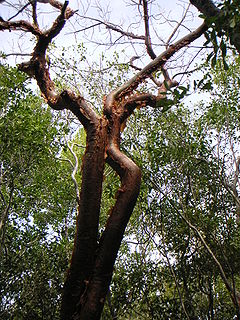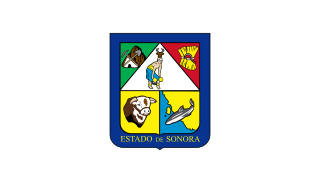
Bursera graveolens, known in Spanish as palo santo, is a wild tree native to Mexico and the Yucatán Peninsula to Peru and Venezuela that inhabits the South American Gran Chaco region. It is also found in Costa Rica, El Salvador, Guatemala, Honduras, Colombia, Ecuador, Peru and on the Galápagos Islands. The tree belongs to the same family (Burseraceae) as frankincense and myrrh. It is widely used in folk medicine for stomach ache, as sudorific, and as liniment for rheumatism. Aged heartwood is rich in terpenes such as limonene and α-terpineol.

Bursera simaruba, commonly known as gumbo-limbo, copperwood, chaca, and turpentine tree, is a tree species in the family Burseraceae, native to tropical regions of the Americas from South Florida to Mexico and the Caribbean to Brazil, Jinotega and Venezuela. Bursera simaruba are prevalent in the Petenes mangroves ecoregion of the Yucatán, where it is a subdominant plant species to mangroves.

Acacia stenophylla, the shoestring acacia, is an evergreen tree in the family Fabaceae native to Australia
Juniperus coahuilensis, commonly known as redberry juniper, is a species of conifer in the family Cupressaceae.

Bursera microphylla is a North American species of tree in the frankincense family in the soapwood order. Bursera microphylla, known by the common name elephant tree in English or 'torote' in Spanish, is a tree in genus Bursera. It grows into a distinctive sculptural form, with a thickened, water-storing or caudiciform trunk. It is found in the southwestern United States and northwestern Mexico.

The Gila Mountains of Yuma County are a 26-mile (42 km) long mountain range in southwestern Arizona in the northwest Sonoran Desert.
Bursera glabrifolia is a Mexican species of trees native to central Mexico.
The Tule Mountains is a mountain range in Yuma County, Arizona. There is a diverse flora and fauna population within the Tule Mountains; one of the notable trees found in this mountain range is the elephant tree.
The Sierra de San Francisco is a mountain range in Mulegé Municipality of the northern region of Baja California Sur state, in northwestern Mexico.

Bursera fagaroides is a species of flowering plant in the genus Bursera known by the common names torchwood copal and fragrant bursera. It is widespread across much of Mexico from Sonora to Oaxaca, and its range extends just into Arizona in the United States, although some sources suggest that it may now be extirpated in Arizona.
Copal tree may refer to several tree species:
Bursera bipinnata is a Mesoamerican species of trees widespread across Mexico and Central America from Chihuahua to Honduras.
Bursera cerasifolia is an uncommon North American species of trees in the Frankincense Family in the soapwood order. It has been found only in the State of Baja California Sur in northwestern Mexico.
Bursera filicifolia is an uncommon North American species of trees in the Frankincense Family in the soapwood order. It has been found only in the States of Sonora and Baja California Sur in northwestern Mexico.
Bursera grandifolia is a Mexican species of trees in the frankincense family in the soapwood order. It is widespread across much of Mexico from Sonora to the Yucatán Peninsula, and found also in Central America as far south as Costa Rica.
Bursera hindsiana is a Mexican species of trees in the frankincense family in the soapwood order. It grows in Sonora and in both of the states of Baja California. This includes several of the islands in the Gulf of California.
Bursera lancifolia is a Mexican species of trees in the frankincense family in the soapwood order. It is widespread in western Mexico from Sonora to Oaxaca.

Bursera penicillata is a Mexican species of trees in the frankincense family in the soapwood order. It is widespread in much of Mexico from Sonora and Chihuahua to Oaxaca and Veracruz.









